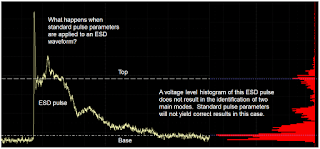 |
| Figure 1: The IEEE's pulse definitions, which don't fit the bill for measuring ESD pulses |
When oscilloscopes measure pulses, the IEEE definition requires them to measure the top and base of the waveform (Figure 1). You can see why when you take into account the histogram of a typical pulse. The top and base give you the steady-state high and low values, which is what you're typically looking for when you measure something like a clock pulse.
 |
| Figure 2: Determining a clock signal's top and base from a voltage histogram |
Figure 2 shows how a clock signal's top and base are correctly determined from a voltage histogram. The image shows a real clock signal with the histogram superimposed on the Y axis. We can clearly see the two main modes as labeled in the image, which denote the steady-state values of the top and base.
 |
| Figure 3: Applying IEEE pulse definitions to an ESD pulse deliver misleading results |
 |
| Figure 4: A misapprehension of the top level of an ESD pulse skews 10% to 90% rise time measurements |
EMC pulse definitions, such as those of the IEC 61000-4-2 standard, use 0% and Maximum instead of Top and Base to calculate the 10% to 90% rise time (Figure 5). By default, virtually all oscilloscopes on the market will use the IEEE Std 181-2003 pulse definitions to perform these measurements. But on the other hand, virtually all modern oscilloscopes will permit the operator to manually override the default threshold settings to measure from 0% (ground) to 100% amplitude. It is these voltage levels that are the proper starting point for determining the 10% to 90% rise time values.
 |
| Figure 5: Use 0% and Maximum to calculate accurate rise time results |
For comparison's sake, using the 10%-90% approach on a representative EMC pulse yielded a rise time measurement of 494 ps. But manually switching the measurement levels to 0%-Maximum results in a measurement of 854 ps, which is the correct result.
By the way, the same caution applies to pulse width measurements, which will be similarly skewed by an oscilloscope's default measurement settings. Oscilloscopes typically default to a 50% value for pulse-width measurements. As with rise time measurements, the level should be manually set to 0%-Maximum to ensure an accurate result.
Stay tuned for upcoming Test Happens posts on this topic!
No comments:
Post a Comment